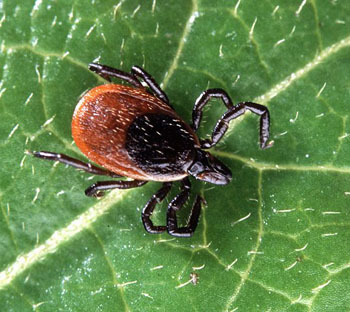Likely Flaws Uncovered for LM-Method for Lyme Disease Detection
By LabMedica International staff writers
Posted on 12 Jul 2016
According to a new study, the recently developed modified microscopy technique “LM-method” of examining blood samples to help diagnose Lyme disease (and babesiosis) – is unable to distinguish infected patients from healthy controls, yielding many false-positive results.Posted on 12 Jul 2016
While most people who contract Lyme disease recover quickly after antibiotic treatment, up to 20% of patients report persistent symptoms years after being told standard tests are negative for the disease. Interest in new diagnostic tests is therefore high.

Image: An adult deer tick Ixodes scapularis. Lyme disease is caused by Borrelia bacteria and transmitted to humans upon the bite of infected ticks of the genus Ixodes (Photo courtesy of Scott Bauer, Agricultural Research Service of USDA / Wikimedia).
The tick vector Ixodidae transmits Borrelia (bacterial causative agent of Lyme disease) as well as Babesia (parasitic protozoan causative agent of babesiosis). The new research follows up on a previous study suggesting that LM-method could detect active cases of disease caused by Borrelia and/or Babesia in just 1-2 days. Considerable publicity, and thereby patient demand, for this test in Norway continued despite that earlier studies did not include a control group and methods were not validated and ready for use in patients.
To investigate the reliability of the new test, Dr Audun Aase, from the Norwegian Institute of Public Health (Oslo, Norway), and colleagues collected blood samples from people who had been suffering from Lyme disease-like symptoms for several years and previously tested positive for Borrelia and/or Babesia infection using LM-method (21 people), and from healthy controls with no known history of tick bites (41 people). The samples were then masked and analyzed in independent laboratories using a range of diagnostic tests including the LM-method, conventional microscopy, genetic fingerprint testing (PCR), and serology.
The study indicated that LM-method results in high numbers of false positives: 14 (66%) patient-group samples and 35 (85%) control-group samples were judged positive for Borrelia and/or Babesia. However, only 1 sample (5%) of the patient-group and 8 samples (20%) of the control-group tested positive for Borrelia DNA by PCR. None of the samples were positive for Babesia DNA, and conventional microscopy did not identify Babesia in any of the samples. In conclusion, the structures interpreted as Borrelia and Babesia using LM-method could not be verified by PCR and the LM-method was thus falsified.
In an accompanying editorial commentary, Dr Ram B. Dessau, infectious diseases expert and senior consultant at Slagelse Hospital (Slagelse, Denmark), wrote: “I hope the study serves as a warning against non-validated microscopic procedures and helps prevent mismanagement of patients with chronic complaints, who are lured to seek improper diagnosis in the future.”
The study, by Aase A et al, was published online February 2016 in the journal Infectious Diseases.
Related Links:
Norwegian Institute of Public Health













